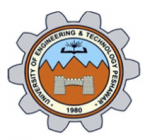The gold cyanidation/leaching process is the most versatile processing technique used for extraction of gold utilizing
different cyanidation parameters likes grinding time, pH, cyanidation time, sodium cyanide (NaCN) and lime CaO..
The efficiency of cyanidation process depends on dosage of each parameter. In present research work the extraction
of gold and silver by cyanidation process from shoughur area of district Chitral, Khyber Pakhtunkhwa was carried
out at laboratory scale. The three representative samples ground at time 25, 30 to 35 minutes and roasted at 650 oc
for 1 hour were subjected to agitation cyanidation process at varying dosage of pH from 10 to 11.13 , CaO from 0.5
to 1.5 gm/kg, NaCN varies from 1 gram to 5.93 gram and cyanidation time varies from 0 to 39 hours. The maximum
grade of 71.82 ppm with 99.03% extraction/recovery of gold and 34.34 ppm with 73.83% extraction of silver was
obtained for 30 minutes ground sample at dosage of sodium cyanide (NaCN) of 5.33 gram, pH 10.40, CaO of 1.5
gram, and cyanidation time of 37 hours as compared to 25 and 35 minutes ground samples. The cyanidation process
was also applied on un-roasted ground ore samples at 30 and 35 minutes, pH 10.40, lime of 1.5gm/kg and varying
cyanidation time from 2 to 37 hours. The maximum grade of gold 11.95 ppm and silver 11.50 ppm was extracted.
Based on the comparative analysis of result it is concluded that cyanidation process on roasted ore samples gives
better results as compared to un-roasted ore samples.





